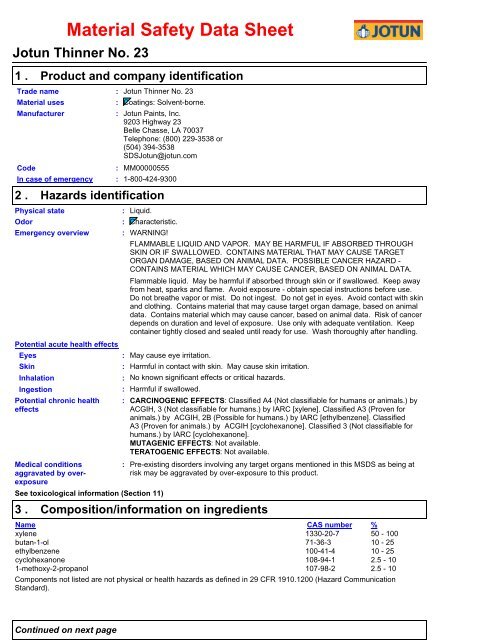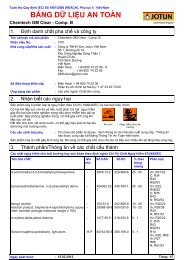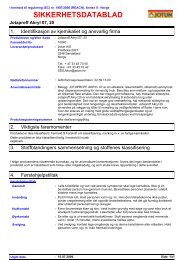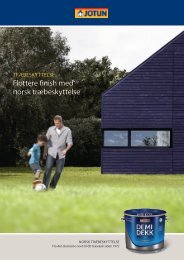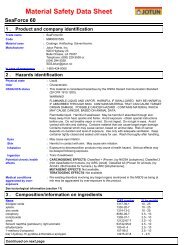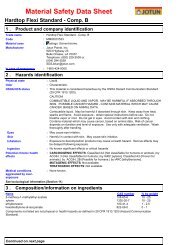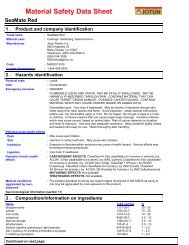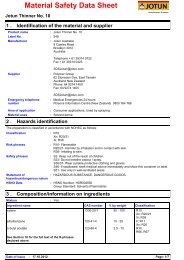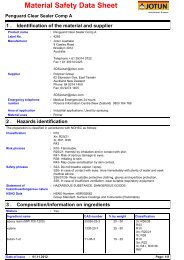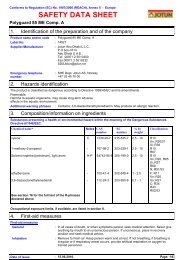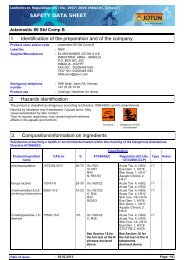Jotun Thinner No. 23 - Marine_Protective - English (us) - Canada
Jotun Thinner No. 23 - Marine_Protective - English (us) - Canada
Jotun Thinner No. 23 - Marine_Protective - English (us) - Canada
Create successful ePaper yourself
Turn your PDF publications into a flip-book with our unique Google optimized e-Paper software.
Material Safety Data Sheet<strong>Jotun</strong> <strong>Thinner</strong> <strong>No</strong>. <strong>23</strong>1 .Product and company identificationTrade nameMaterial <strong>us</strong>esManufacturerCodeIn case of emergency2 .Hazards identificationPhysical stateOdorEmergency overviewPotential acute health effectsEyesSkinInhalationIngestionPotential chronic healtheffectsMedical conditionsaggravated by overexposureSee toxicological information (Section 11)3 .: <strong>Jotun</strong> <strong>Thinner</strong> <strong>No</strong>. <strong>23</strong>: Coatings: Solvent-borne.: <strong>Jotun</strong> Paints, Inc.9203 Highway <strong>23</strong>Belle Chasse, LA 70037Telephone: (800) 229-3538 or(504) 394-3538SDS<strong>Jotun</strong>@jotun.com: MM00000555: 1-800-424-9300: Liquid.: Characteristic.: WARNING!FLAMMABLE LIQUID AND VAPOR. MAY BE HARMFUL IF ABSORBED THROUGHSKIN OR IF SWALLOWED. CONTAINS MATERIAL THAT MAY CAUSE TARGETORGAN DAMAGE, BASED ON ANIMAL DATA. POSSIBLE CANCER HAZARD -CONTAINS MATERIAL WHICH MAY CAUSE CANCER, BASED ON ANIMAL DATA.Flammable liquid. May be harmful if absorbed through skin or if swallowed. Keep awayfrom heat, sparks and flame. Avoid exposure - obtain special instructions before <strong>us</strong>e.Do not breathe vapor or mist. Do not ingest. Do not get in eyes. Avoid contact with skinand clothing. Contains material that may ca<strong>us</strong>e target organ damage, based on animaldata. Contains material which may ca<strong>us</strong>e cancer, based on animal data. Risk of cancerdepends on duration and level of exposure. Use only with adequate ventilation. Keepcontainer tightly closed and sealed until ready for <strong>us</strong>e. Wash thoroughly after handling.: May ca<strong>us</strong>e eye irritation.: Harmful in contact with skin. May ca<strong>us</strong>e skin irritation.: <strong>No</strong> known significant effects or critical hazards.: Harmful if swallowed.: CARCINOGENIC EFFECTS: Classified A4 (<strong>No</strong>t classifiable for humans or animals.) byACGIH, 3 (<strong>No</strong>t classifiable for humans.) by IARC [xylene]. Classified A3 (Proven foranimals.) by ACGIH, 2B (Possible for humans.) by IARC [ethylbenzene]. ClassifiedA3 (Proven for animals.) by ACGIH [cyclohexanone]. Classified 3 (<strong>No</strong>t classifiable forhumans.) by IARC [cyclohexanone].MUTAGENIC EFFECTS: <strong>No</strong>t available.TERATOGENIC EFFECTS: <strong>No</strong>t available.:Pre-existing disorders involving any target organs mentioned in this MSDS as being atrisk may be aggravated by over-exposure to this product.Composition/information on ingredientsName CAS number %xylene 1330-20-7 50 - 100butan-1-ol 71-36-3 10 - 25ethylbenzene 100-41-4 10 - 25cyclohexanone 108-94-1 2.5 - 101-methoxy-2-propanol 107-98-2 2.5 - 10Components not listed are not physical or health hazards as defined in 29 CFR 1910.1200 (Hazard CommunicationStandard).Continued on next page
<strong>Jotun</strong> <strong>Thinner</strong> <strong>No</strong>. <strong>23</strong> Page: 2/84 .First aid measuresEye contactSkin contactInhalationIngestionProtection of first-aiders::::Check for and remove any contact lenses. Immediately fl<strong>us</strong>h eyes with plenty ofwater for at least 15 minutes, occasionally lifting the upper and lower eyelids. Getmedical attention immediately.In case of contact, immediately fl<strong>us</strong>h skin with plenty of water for at least 15 minuteswhile removing contaminated clothing and shoes. Wash clothing before re<strong>us</strong>e.Clean shoes thoroughly before re<strong>us</strong>e. Get medical attention immediately.Move exposed person to fresh air. If not breathing, if breathing is irregular or ifrespiratory arrest occurs, provide artificial respiration or oxygen by trained personnel.Loosen tight clothing such as a collar, tie, belt or waistband. Get medical attentionimmediately.Wash out mouth with water. Do not induce vomiting unless directed to do so bymedical personnel. Never give anything by mouth to an unconscio<strong>us</strong> person. Getmedical attention immediately.: <strong>No</strong> action shall be taken involving any personal risk or without suitable training. Itmay be dangero<strong>us</strong> to the person providing aid to give mouth-to-mouth res<strong>us</strong>citation.Wash contaminated clothing thoroughly with water before removing it, or weargloves.5 .Fire-fighting measuresFlammability of the productProducts of comb<strong>us</strong>tionExtinguishing mediaSpecial protectiveequipment for fire-fighters::Suitable :<strong>No</strong>t suitable :Special exposure hazards ::May be comb<strong>us</strong>tible at high temperature.Decomposition products may include the following materials:carbon dioxidecarbon monoxideUse dry chemical, CO2, water spray (fog) or foam.Do not <strong>us</strong>e water jet.Promptly isolate the scene by removing all persons from the vicinity of the incident ifthere is a fire. <strong>No</strong> action shall be taken involving any personal risk or without suitabletraining. Move containers from fire area if this can be done without risk. Use waterspray to keep fire-exposed containers cool.Flammable liquid. In a fire or if heated, a pressure increase will occur and the containermay burst, with the risk of a subsequent explosion. Runoff to sewer may create fire orexplosion hazard.Fire-fighters should wear appropriate protective equipment and self-contained breathingapparat<strong>us</strong> (SCBA) with a full face-piece operated in positive pressure mode.6 .Accidental release measuresPersonal precautions :Environmental precautionsMethods for cleaning up :<strong>No</strong> action shall be taken involving any personal risk or without suitable training.Evacuate surrounding areas. Keep unnecessary and unprotected personnel fromentering. Do not touch or walk through spilled material. Shut off all ignition sources.<strong>No</strong> flares, smoking or flames in hazard area. Avoid breathing vapor or mist. Provideadequate ventilation. Wear appropriate respirator when ventilation is inadequate.Put on appropriate personal protective equipment (see Section 8).: Avoid dispersal of spilled material and runoff and contact with soil, waterways, drainsand sewers. Inform the relevant authorities if the product has ca<strong>us</strong>ed environmentalpollution (sewers, waterways, soil or air).Stop leak if without risk. Move containers from spill area. Approach release fromupwind. Prevent entry into sewers, water courses, basements or confined areas.Wash spillages into an effluent treatment plant or proceed as follows. Contain andcollect spillage with non-comb<strong>us</strong>tible, absorbent material e.g. sand, earth, vermiculiteor diatomaceo<strong>us</strong> earth and place in container for disposal according to localregulations (see section 13). Use spark-proof tools and explosion-proof equipment.Dispose of via a licensed waste disposal contractor. Contaminated absorbentmaterial may pose the same hazard as the spilled product. <strong>No</strong>te: see section 1 foremergency contact information and section 13 for waste disposal.Continued on next page
<strong>Jotun</strong> <strong>Thinner</strong> <strong>No</strong>. <strong>23</strong> Page: 3/87 .HandlingHandling and storage:Put on appropriate personal protective equipment (see Section 8). Eating, drinkingand smoking should be prohibited in areas where this material is handled, stored andprocessed. Workers should wash hands and face before eating, drinking andsmoking. Remove contaminated clothing and protective equipment before enteringeating areas. Do not get in eyes or on skin or clothing. Do not ingest. Avoidbreathing vapor or mist. Use only with adequate ventilation. Wear appropriaterespirator when ventilation is inadequate. Do not enter storage areas and confinedspaces unless adequately ventilated. Keep in the original container or an approvedalternative made from a compatible material, kept tightly closed when not in <strong>us</strong>e.Store and <strong>us</strong>e away from heat, sparks, open flame or any other ignition source. Useexplosion-proof electrical (ventilating, lighting and material handling) equipment.Use non-sparking tools. Take precautionary measures against electrostaticdischarges. To avoid fire or explosion, dissipate static electricity during transfer bygrounding and bonding containers and equipment before transferring material.Empty containers retain product residue and can be hazardo<strong>us</strong>. Do not re<strong>us</strong>econtainer.Storage:Store in accordance with local regulations. Store in a segregated and approvedarea. Store in original container protected from direct sunlight in a dry, cool and wellventilatedarea, away from incompatible materials (see section 10) and food anddrink. Eliminate all ignition sources. Separate from oxidizing materials. Keepcontainer tightly closed and sealed until ready for <strong>us</strong>e. Containers that have beenopened m<strong>us</strong>t be carefully resealed and kept upright to prevent leakage. Do not storein unlabeled containers. Use appropriate containment to avoid environmentalcontamination.8 .Product nameExposure controls/personal protectionExposure limitsxylene CA Alberta Provincial (<strong>Canada</strong>, 4/2009).8 hrs OEL: 100 ppm 8 hour(s).15 min OEL: 651 mg/m³ 15 minute(s).15 min OEL: 150 ppm 15 minute(s).8 hrs OEL: 434 mg/m³ 8 hour(s).CA British Columbia Provincial (<strong>Canada</strong>, 10/2009).TWA: 100 ppm 8 hour(s).STEL: 150 ppm 15 minute(s).CA Ontario Provincial (<strong>Canada</strong>, 8/2008).TWAEV: 100 ppm 8 hour(s).TWAEV: 435 mg/m³ 8 hour(s).STEV: 150 ppm 15 minute(s).STEV: 650 mg/m³ 15 minute(s).CA Quebec Provincial (<strong>Canada</strong>, 6/2008).TWAEV: 100 ppm 8 hour(s).TWAEV: 434 mg/m³ 8 hour(s).STEV: 150 ppm 15 minute(s).STEV: 651 mg/m³ 15 minute(s).butan-1-ol CA British Columbia Provincial (<strong>Canada</strong>, 9/2010).C: 30 ppm 15 minute(s).TWA: 15 ppm 8 hour(s).CA Ontario Provincial (<strong>Canada</strong>, 7/2010).TWA: 20 ppm 8 hour(s).CA Quebec Provincial (<strong>Canada</strong>, 6/2008). Absorbed through skin.STEV: 152 mg/m³ 15 minute(s).STEV: 50 ppm 15 minute(s).CA Alberta Provincial (<strong>Canada</strong>, 4/2009). Skin sensitizer.8 hrs OEL: 60 mg/m³ 8 hour(s).8 hrs OEL: 20 ppm 8 hour(s).ethylbenzene CA Alberta Provincial (<strong>Canada</strong>, 6/2008).8 hrs OEL: 100 ppm 8 hour(s).8 hrs OEL: 434 mg/m³ 8 hour(s).15 min OEL: 543 mg/m³ 15 minute(s).15 min OEL: 125 ppm 15 minute(s).CA British Columbia Provincial (<strong>Canada</strong>, 6/2008).Continued on next page
<strong>Jotun</strong> <strong>Thinner</strong> <strong>No</strong>. <strong>23</strong> Page: 4/88 .Exposure controls/personal protectionTWA: 100 ppm 8 hour(s).STEL: 125 ppm 15 minute(s).CA Ontario Provincial (<strong>Canada</strong>, 6/2008).TWAEV: 100 ppm 8 hour(s).TWAEV: 435 mg/m³ 8 hour(s).STEV: 125 ppm 15 minute(s).STEV: 540 mg/m³ 15 minute(s).CA Quebec Provincial (<strong>Canada</strong>, 6/2008).TWAEV: 100 ppm 8 hour(s).TWAEV: 434 mg/m³ 8 hour(s).STEV: 125 ppm 15 minute(s).STEV: 543 mg/m³ 15 minute(s).cyclohexanoneCA Alberta Provincial (<strong>Canada</strong>, 4/2009). Absorbed through skin.8 hrs OEL: 20 ppm 8 hour(s).8 hrs OEL: 80 mg/m³ 8 hour(s).15 min OEL: 200 mg/m³ 15 minute(s).15 min OEL: 50 ppm 15 minute(s).CA British Columbia Provincial (<strong>Canada</strong>, 9/2010). Absorbed throughskin.TWA: 20 ppm 8 hour(s).STEL: 50 ppm 15 minute(s).CA Ontario Provincial (<strong>Canada</strong>, 7/2010). Absorbed through skin.TWA: 20 ppm 8 hour(s).STEL: 50 ppm 15 minute(s).CA Quebec Provincial (<strong>Canada</strong>, 6/2008). Absorbed through skin.TWAEV: 25 ppm 8 hour(s).TWAEV: 100 mg/m³ 8 hour(s).1-methoxy-2-propanol CA Alberta Provincial (<strong>Canada</strong>, 4/2009).15 min OEL: 553 mg/m³ 15 minute(s).15 min OEL: 150 ppm 15 minute(s).8 hrs OEL: 369 mg/m³ 8 hour(s).8 hrs OEL: 100 ppm 8 hour(s).CA British Columbia Provincial (<strong>Canada</strong>, 9/2010).STEL: 75 ppm 15 minute(s).TWA: 50 ppm 8 hour(s).CA Ontario Provincial (<strong>Canada</strong>, 7/2010).STEL: 553 mg/m³ 15 minute(s).STEL: 150 ppm 15 minute(s).TWA: 369 mg/m³ 8 hour(s).TWA: 100 ppm 8 hour(s).CA Quebec Provincial (<strong>Canada</strong>, 6/2008).STEV: 553 mg/m³ 15 minute(s).STEV: 150 ppm 15 minute(s).TWAEV: 369 mg/m³ 8 hour(s).TWAEV: 100 ppm 8 hour(s).Engineering measuresPersonal protectionEyesSkinRespiratory: Use only with adequate ventilation. Use process enclosures, local exha<strong>us</strong>t ventilation orother engineering controls to keep worker exposure to airborne contaminants below anyrecommended or statutory limits. The engineering controls also need to keep gas, vaporor d<strong>us</strong>t concentrations below any lower explosive limits. Use explosion-proof ventilationequipment.:::Safety eyewear complying with an approved standard should be <strong>us</strong>ed when a riskassessment indicates this is necessary to avoid exposure to liquid splashes, mists ord<strong>us</strong>ts.Personal protective equipment for the body should be selected based on the task beingperformed and the risks involved and should be approved by a specialist before handlingthis product.Use a properly fitted, air-purifying or air-fed respirator complying with an approvedstandard if a risk assessment indicates this is necessary. Respirator selection m<strong>us</strong>t bebased on known or anticipated exposure levels, the hazards of the product and the safeworking limits of the selected respirator.Continued on next page
<strong>Jotun</strong> <strong>Thinner</strong> <strong>No</strong>. <strong>23</strong> Page: 5/88 .Exposure controls/personal protectionHands :Hygiene measuresChemical-resistant, impervio<strong>us</strong> gloves complying with an approved standard should beworn at all times when handling chemical products if a risk assessment indicates this isnecessary.: Wash hands, forearms and face thoroughly after handling chemical products, beforeeating, smoking and <strong>us</strong>ing the lavatory and at the end of the working period. Appropriatetechniques should be <strong>us</strong>ed to remove potentially contaminated clothing. Washcontaminated clothing before re<strong>us</strong>ing. Ensure that eyewash stations and safety showersare close to the workstation location.9 .Physical and chemical propertiesPhysical stateFlash pointColorOdorRelative densitySolubility: Liquid.: Closed cup: 24°C (75,2°F): Clear.: Characteristic.: 0.87 g/cm 37.26 pounds/gallon866 % (w/w): Insoluble in the following materials: cold water and hot water.10 .Stability and reactivityStability and reactivityHazardo<strong>us</strong> decompositionproductsHazardo<strong>us</strong> polymerization11 .:::The product is stable.Toxicological informationUnder normal conditions of storage and <strong>us</strong>e, hazardo<strong>us</strong> decomposition productsshould not be produced.Under normal conditions of storage and <strong>us</strong>e, hazardo<strong>us</strong> polymerization will notoccur.Chronic effects on humansOther toxic effects onhumansSpecific effectsCarcinogenic effectsMutagenic effectsReproduction toxicityChronic effectsTarget organs:::::::CARCINOGENIC EFFECTS: Classified A4 (<strong>No</strong>t classifiable for humans or animals.)by ACGIH, 3 (<strong>No</strong>t classifiable for humans.) by IARC [xylene]. Classified A3 (Provenfor animals.) by ACGIH, 2B (Possible for humans.) by IARC [ethylbenzene].Classified A3 (Proven for animals.) by ACGIH [cyclohexanone]. Classified 3 (<strong>No</strong>tclassifiable for humans.) by IARC [cyclohexanone].Contains material which may ca<strong>us</strong>e damage to the following organs: kidneys, lungs,liver, muco<strong>us</strong> membranes, spleen, upper respiratory tract, skin, central nervo<strong>us</strong>system (CNS), ears, eye, lens or cornea.Exposure to component solvent vapor concentrations in excess of the statedoccupational exposure limit may result in adverse health effects such as muco<strong>us</strong>membrane and respiratory system irritation and adverse effects on the kidneys, liverand central nervo<strong>us</strong> system. Solvents may ca<strong>us</strong>e some of the above effects byabsorption through the skin. Symptoms and signs include headache, dizziness,fatigue, m<strong>us</strong>cular weakness, drowsiness and, in extreme cases, loss ofconscio<strong>us</strong>ness. Repeated or prolonged contact with the preparation may ca<strong>us</strong>eremoval of natural fat from the skin, resulting in non-allergic contact dermatitis andabsorption through the skin. If splashed in the eyes, the liquid may ca<strong>us</strong>e irritationand reversible damage. Swallowing may ca<strong>us</strong>e na<strong>us</strong>ea, diarrhea, vomiting, gastrointestinalirritation and chemical pneumonia.Contains material which may ca<strong>us</strong>e cancer, based on animal data. Risk of cancerdepends on duration and level of exposure.<strong>No</strong> known significant effects or critical hazards.<strong>No</strong> known significant effects or critical hazards.Contains material that may ca<strong>us</strong>e target organ damage, based on animal data.Contains material which may ca<strong>us</strong>e damage to the following organs: kidneys, lungs,liver, muco<strong>us</strong> membranes, spleen, upper respiratory tract, skin, central nervo<strong>us</strong>system (CNS), ears, eye, lens or cornea.Continued on next page
<strong>Jotun</strong> <strong>Thinner</strong> <strong>No</strong>. <strong>23</strong> Page: 6/812 .Ecological informationEcotoxicity dataProduct/ingredient name Species Period ResultxyleneOncorhynch<strong>us</strong> mykiss (LC50)Oncorhynch<strong>us</strong> mykiss (LC50)Lepomis macrochir<strong>us</strong> (LC50)Lepomis macrochir<strong>us</strong> (LC50)Lepomis macrochir<strong>us</strong> (LC50)Pimephales promelas (LC50)96 hour(s)96 hour(s)96 hour(s)96 hour(s)96 hour(s)96 hour(s)3.3 mg/l8.2 mg/l8.6 mg/l12 mg/l13.3 mg/l13.4 mg/lbutan-1-olethylbenzenecyclohexanoneEnvironmental precautionsProducts of degradation13 .Disposal considerationsWaste disposalDaphnia magna (EC50)Lepomis macrochir<strong>us</strong> (LC50)Pimephales promelas (LC50)Pimephales promelas (LC50)Pimephales promelas (LC50)Daphnia magna (EC50)Daphnia magna (EC50)Selenastrum capricornutum(EC50)Oncorhynch<strong>us</strong> mykiss (LC50)Pimephales promelas (LC50)Poecilia reticulata (LC50)Pimephales promelas (LC50)Pimephales promelas (LC50)Pimephales promelas (LC50)48 hour(s)96 hour(s)96 hour(s)96 hour(s)96 hour(s)48 hour(s)48 hour(s)48 hour(s)96 hour(s)96 hour(s)96 hour(s)96 hour(s)96 hour(s)96 hour(s): <strong>No</strong> known significant effects or critical hazards.: Products of degradation: carbon oxides (CO, CO2) and water.:1983 mg/l100 mg/l1730 mg/l1910 mg/l1940 mg/l2.93 mg/l2.97 mg/l7.2 mg/l4.2 mg/l9.09 mg/l9.6 mg/l527 mg/l630 mg/l732 mg/lThe generation of waste should be avoided or minimized wherever possible. Significantquantities of waste product residues should not be disposed of via the foul sewer butprocessed in a suitable effluent treatment plant. Dispose of surpl<strong>us</strong> and non-recyclableproducts via a licensed waste disposal contractor. Disposal of this product, solutionsand any by-products should at all times comply with the requirements of environmentalprotection and waste disposal legislation and any regional local authority requirements.Waste packaging should be recycled. Incineration or landfill should only be consideredwhen recycling is not feasible. This material and its container m<strong>us</strong>t be disposed of in asafe way. Care should be taken when handling emptied containers that have not beencleaned or rinsed out. Empty containers or liners may retain some product residues.Vapor from product residues may create a highly flammable or explosive atmosphereinside the container. Do not cut, weld or grind <strong>us</strong>ed containers unless they have beencleaned thoroughly internally. Avoid dispersal of spilled material and runoff and contactwith soil, waterways, drains and sewers.Disposal should be in accordance with applicable regional, national and local laws and regulations. Localregulations may be more stringent than regional or national requirements.The information presented below only applies to the material as supplied. The identification based oncharacteristic(s) or listing may not apply if the material has been <strong>us</strong>ed or otherwise contaminated. It is theresponsibility of the waste generator to determine the toxicity and physical properties of the material generated todetermine the proper waste identification and disposal methods in compliance with applicable regulations.Refer to Section 7: HANDLING AND STORAGE and Section 8: EXPOSURE CONTROLS/PERSONAL PROTECTIONfor additional handling information and protection of employees.14 .Transport informationContinued on next page
<strong>Jotun</strong> <strong>Thinner</strong> <strong>No</strong>. <strong>23</strong> Page: 7/814 .Transport informationRegulatoryinformationUN numberProper shippingnameClass PG* Label AdditionalinformationDOT Classification1263Paint related material3 III-TDG Classification 1263 Paint related material 3 III-ADR/RID Class 1263 Paint related material 3 IIIIMDG Class 1263 Paint related material 3 IIITunnel restrictioncode: (D/E)Hazard identificationnumber: 30Special provisions:640EEmergency schedules(EmS): F-E, S-E<strong>Marine</strong> pollutant: <strong>No</strong>.IATA-DGR Class 1263 Paint related material 3III-PG* : Packing group-15 .Regulatory informationWHMIS (<strong>Canada</strong>):Class B-2: Flammable liquidClass D-1B: Material ca<strong>us</strong>ing immediate and serio<strong>us</strong> toxic effects (Toxic).Class D-2A: Material ca<strong>us</strong>ing other toxic effects (Very toxic).Class D-2B: Material ca<strong>us</strong>ing other toxic effects (Toxic).CEPA Toxic substances: <strong>No</strong>ne of the components are listed.Canadian ARET: <strong>No</strong>ne of the components are listed.Canadian NPRI: The following components are listed: Xylene; Ethylbenzene; n-ButylalcoholAlberta Designated Substances: <strong>No</strong>ne of the components are listed.Ontario Designated Substances: <strong>No</strong>ne of the components are listed.Quebec Designated Substances: <strong>No</strong>ne of the components are listed.This product has been classified in accordance with the hazard criteria of the Controlled Products Regulations andthe MSDS contains all the information required by the Controlled Products Regulations.EU regulationsHazard symbol or symbols :HarmfulContinued on next page
<strong>Jotun</strong> <strong>Thinner</strong> <strong>No</strong>. <strong>23</strong> Page: 8/815 .Regulatory informationRisk phrasesSafety phrases::R10- Flammable.R20/21- Harmful by inhalation and in contact with skin.R41- Risk of serio<strong>us</strong> damage to eyes.R37/38- Irritating to respiratory system and skin.S<strong>23</strong>- Do not breathe vapor / spray.S26- In case of contact with eyes, rinse immediately with plenty of water and seekmedical advice.S36/37/39- Wear suitable protective clothing, gloves and eye/face protection.S38- In case of insufficient ventilation, wear suitable respiratory equipment.16 .Other informationDate of issueVersion<strong>No</strong>tice to reader::17.10.2012.1.01To the best of our knowledge, the information contained herein is accurate. However, neither the above-namedsupplier, nor any of its subsidiaries, assumes any liability whatsoever for the accuracy or completeness of theinformation contained herein.Final determination of suitability of any material is the sole responsibility of the <strong>us</strong>er. All materials may presentunknown hazards and should be <strong>us</strong>ed with caution. Although certain hazards are described herein, we cannotguarantee that these are the only hazards that exist.Indicates information that has changed from previo<strong>us</strong>ly issued version.


